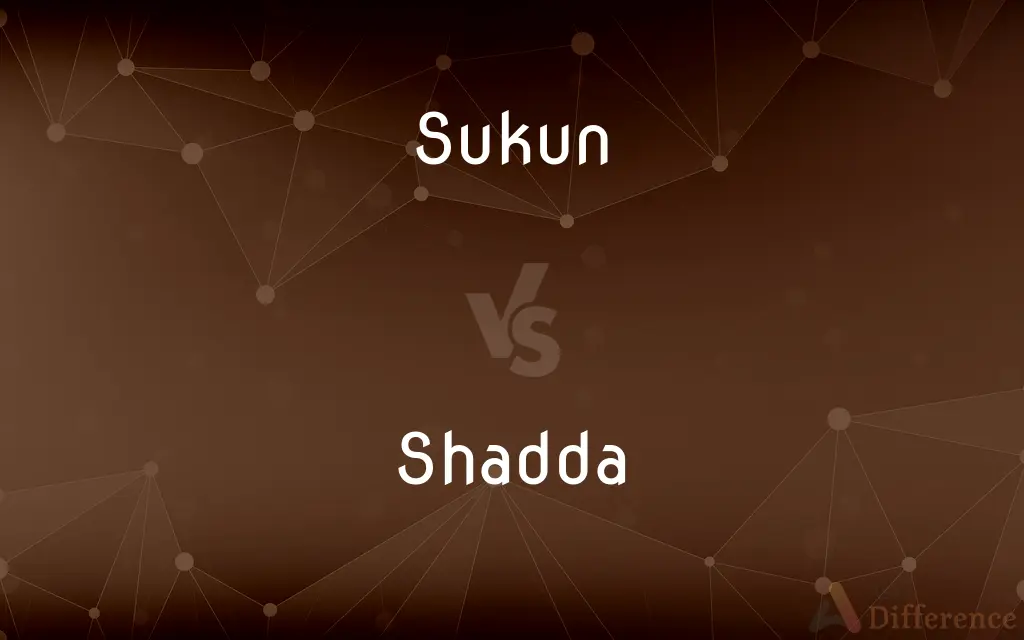Sukun vs. Shadda — What's the Difference?
By Fiza Rafique & Urooj Arif — Updated on April 29, 2024
Sukun is a diacritic in Arabic script indicating no vowel follows a consonant, while Shadda signifies consonant doubling or gemination.

Difference Between Sukun and Shadda
Table of Contents
ADVERTISEMENT
Key Differences
Sukun, represented as a small circle above a consonant in Arabic script, signals that the consonant is not followed by a vowel, affecting pronunciation and word meaning. Whereas Shadda, shown as a small "w"-shaped sign above a consonant, indicates that the consonant is to be doubled or geminated, profoundly impacting the pronunciation and sometimes the meaning of words.
In phonetic terms, sukun affects the flow of speech by halting vowel sounds, which can change the tempo and rhythm of spoken Arabic. On the other hand, Shadda increases the emphasis on the consonant it marks, making the sound longer and more pronounced, which can also affect the rhythmic quality of speech.
Grammatically, the presence of sukun in a word can affect verb conjugations and noun forms by dictating how syllables are constructed and linked. Shadda, however, primarily affects the intensity or stress within a word, potentially altering its grammatical role or emphasis in a sentence.
In terms of usage, sukun is widely used across different contexts in Arabic to clarify precise pronunciation where vowels are absent. Shadda is often used in words to emphasize certain sounds that are crucial for correct pronunciation and can distinguish between otherwise similar words.
In linguistic impact, while both sukun and shadda serve to guide pronunciation, sukun is essential for indicating the absence of vowels, helping non-native speakers and learners of Arabic. Shadda, by increasing consonant duration, plays a crucial role in distinguishing meanings and enhancing expressive delivery in spoken Arabic.
ADVERTISEMENT
Comparison Chart
Symbol Appearance
Small circle above a consonant
Small "w" shape above a consonant
Phonetics
Indicates no following vowel
Indicates doubling or gemination of consonant
Grammatical Impact
Affects verb conjugations and noun forms
Affects word stress and grammatical emphasis
Usage Context
Common in all Arabic text for pronunciation
Used for emphasis and distinguishing meanings
Linguistic Effect
Controls vowel presence and flow of speech
Enhances sound duration and expressiveness
Compare with Definitions
Sukun
Diacritic in Arabic indicating no following vowel.
In لمْ, the sukun on م shows no vowel follows.
Shadda
Crucial for expressive Arabic speech.
Poets use shadda to enhance rhythmic and expressive qualities.
Sukun
Present in absence of vowels.
Sukun is essential in fully consonantal word parts.
Shadda
Diacritic in Arabic indicating consonant doubling.
In شَدّة, shadda on د doubles the sound.
Sukun
Enhances pronunciation clarity.
Using sukun, speakers ensure consonant sounds are not altered by vowels.
Shadda
Increases emphasis on consonants.
Shadda makes the consonant it marks sound longer.
Sukun
Used to manage syllable formation.
Sukun helps maintain correct syllable structure in Arabic.
Shadda
Alters word stress and meanings.
جَدّ (grandfather) vs. جَد (seriousness) show how shadda changes meanings.
Sukun
Guides learners in speech.
Learners use sukun to master Arabic pronunciation nuances.
Shadda
Distinguishes similar words.
Shadda differentiates words with otherwise similar spellings and sounds.
Sukun
A diacritic (ـْ) used in the Arabic abjad to mark the absence of a vowel.
Shadda
Shaddah (Arabic: شَدّة shaddah [ˈʃæd.dæ], "[sign of] emphasis", also called by the verbal noun from the same root, tashdid تشديد tashdīd "emphasis") is one of the diacritics used with the Arabic alphabet, indicating a geminated consonant. It is functionally equivalent to writing a consonant twice in the orthographies of languages like Latin, Italian, Swedish, and Ancient Greek, and is thus rendered in Latin script in most schemes of Arabic transliteration, e.g.
Shadda
A diacritic (◌ّ) used in the Arabic script to indicate gemination of a consonant.
Common Curiosities
Why is shadda important in distinguishing meanings in Arabic?
It changes the sound duration of consonants, which can distinguish between words that would otherwise be pronounced similarly.
What is the primary purpose of sukun in Arabic script?
Sukun indicates that the consonant it marks is not followed by a vowel, affecting pronunciation.
Can sukun and shadda appear on the same letter in Arabic?
No, they cannot appear on the same letter as they serve different phonetic purposes.
What role does sukun play in learning Arabic?
It helps learners understand and practice the absence of vowels in pronunciation.
Are sukun and shadda used in all forms of Arabic?
Yes, they are used across Modern Standard Arabic and classical Arabic to guide pronunciation and expression.
How do sukun and shadda influence Arabic poetry?
Sukun controls the flow and rhythm by managing vowel sounds, while shadda enhances rhythmic and expressive qualities through sound emphasis.
How does shadda affect the pronunciation of Arabic words?
Shadda indicates that the consonant it marks should be doubled or geminated, prolonging the sound.
How do non-native speakers benefit from learning about sukun and shadda?
Understanding these diacritics aids in mastering correct pronunciation and comprehension of Arabic nuances.
What is the impact of shadda on Arabic grammar?
Shadda can alter the stress and grammatical emphasis in words, affecting their role in sentences.
What are common mistakes made with sukun and shadda by learners?
Common mistakes include misplacing or omitting these diacritics, leading to incorrect pronunciation and sometimes misunderstanding of words.
Share Your Discovery

Previous Comparison
Maker vs. Manufacturer
Next Comparison
Daisy vs. MargaretAuthor Spotlight
Written by
Fiza RafiqueFiza Rafique is a skilled content writer at AskDifference.com, where she meticulously refines and enhances written pieces. Drawing from her vast editorial expertise, Fiza ensures clarity, accuracy, and precision in every article. Passionate about language, she continually seeks to elevate the quality of content for readers worldwide.
Co-written by
Urooj ArifUrooj is a skilled content writer at Ask Difference, known for her exceptional ability to simplify complex topics into engaging and informative content. With a passion for research and a flair for clear, concise writing, she consistently delivers articles that resonate with our diverse audience.
















































